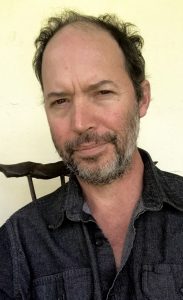
Jared Spears, a UM instructional associate professor of scenic technology, has found ways to overcome the challenges of online teaching and provide benefits for students. Submitted photo
OXFORD, Miss. – The ongoing pandemic has brought many challenges for college professors and students, including a remote, online format for many courses.
But some, including Jared Spears, instructional associate professor of scenic technology at the University of Mississippi, have discovered that the remote format has produced many positive outcomes.
“There have been so many benefits in teaching like this,” Spears said. “My students always pop up on the screen, ready and eager to jump into it.
“Even though we are not physically together, I feel as though I am working with this group closer than ever before because of the individual attention I can give them both inside and outside of class.
Spears is a scenic designer. He fashions sets for theatrical productions, and the first step is creating drawings of the design he would like to produce. These drawings, or renderings, serve as a visual language as he communicates ideas to members of a production’s creative team, including the lighting designer, costume designer and director.
His Rendering for the Theatre course is an entry-level class that gives students broad experience in the fundamentals of theatrical drawing. The techniques are based on life drawing and rendering a variety of objects and people in dramatic light and shadow, the uses of which are central elements in the theater, creating a physical manifestation of the mood and meaning of a scene.
For example, a shift from day to night or from a somber scene to a comic one would involve a corresponding change in the use of light and shadow for presenting actors and sets.
Spears relays a central message to his students in this course: You can’t expect to effectively draw from your imagination if you cannot convincingly draw the world around you.
To make remote learning effective, he encourages students to establish a creative space separate from the rest of their room so they can set up their work and also be seen clearly by the camera on their device. Spears also views it as a necessity to see how students are drawing, not just what they are drawing.
“So much about this relies on hand-eye coordination and how you use your body to draw,” Spears said. “I couldn’t just have my students complete drawings by themselves and show them to me.
“To draw, you really need to engage a lot of muscle processes. I’ve found this to be the best way to accurately represent what you’re seeing.”
As an artist, Spears works with many types of media and has been recognized on both a state and national level. He is a sculptor, with a video documentary of his stone-carving techniques housed in the Rinzler Archives of the Smithsonian Institution’s Center for Folklife and Cultural Heritage and featured as part of the 2005 Smithsonian Folklife Festival in Washington, D.C.
Spears is involved in other art projects, as well. In 2010, he received a special achievement award from the Mississippi Institute of Arts and Letters for his work on a multimedia collaboration titled “The Passions of Walter Anderson: A Dramatic Celebration of the Mississippi Gulf Coast Artist.” He also creates architectural renderings for Southern Living magazine’s “Idea House” series.
Locally, Spears is equally active working in and around the Oxford community. He is represented by Southside Gallery on the Square, which showcases his sculpture and drawings.
Spears has recently created artwork for a poster paying homage to Ron Shapiro, the late Oxford “cultural ambassador.” This poster was commissioned to promote the new ESPN series “TrueSouth,” hosted by John T. Edge, a writer, researcher and founding director of the Southern Foodways Alliance, an institute of the university’s Center for the Study of Southern Culture.
He also is creating artwork and providing art direction for a forthcoming collaborative album by Grammy nominees Andrew Bird and Jimbo Mathus, who founded the acclaimed band Squirrel Nut Zippers.
Spears brings his wealth of professional experience to the classroom.
“I try to give each student a concentrated, 10-minute feedback session,” he said. “I keep them all in one group on the Zoom during this, instead of doing breakout rooms, because I think it is important for all the students to hear every piece of feedback, as they would if we were in the actual studio.”
At the end of each class, Spears has students take a photograph of their work and either text or email it to him for further feedback. He speaks about how this one thing has opened the door for more communication with his students outside the classroom.
Spears hopes this level of accessibility to students is something he will be able to continue and bring back to his Ole Miss classroom after the pandemic is over.
“I think because the formality of the physical classroom is gone, the students seem more eager to share their work with me via email and text,” Spears said. “I’m getting drawings all the time and at all hours.
“It’s recently occurred to me that, though we are removed, we are working a lot closer to achieve our learning and teaching objectives.”
The pandemic has created unique challenges for engaging with students, particularly in the performing arts, said Michael Barnett, chair and professor of lighting design in the Department of Theatre and Film.
“Fortunately, the faculty have worked tirelessly to find creative solutions that not only connect the students to the material, but enhance their learning through the use of tools that might otherwise appear to impose limitations,” Barnett said. “The work that professor Spears has done with this class has introduced new and exciting pathways to learning that will further enhance the educational opportunities for students in the current semester as well as in the years to come.”